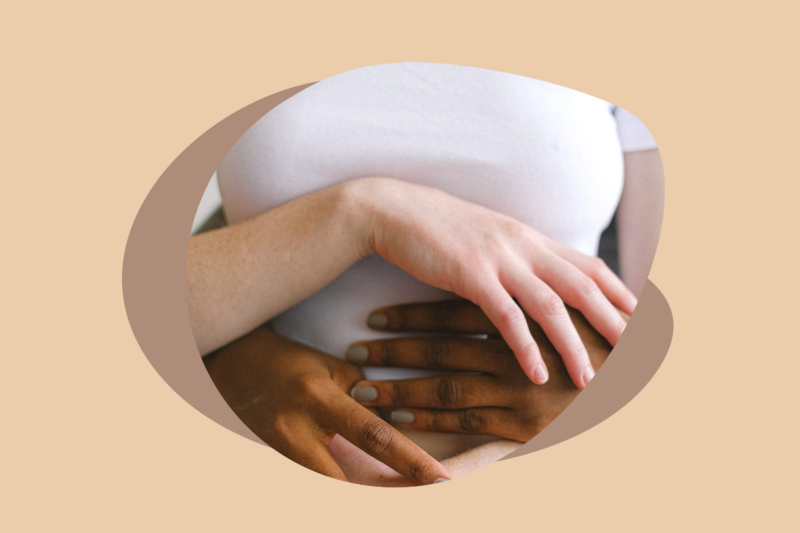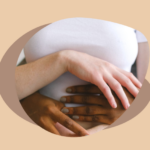Can You Get Pregnant with Endometriosis? Yes – Here’s How
1 in 10 women has endometriosis, a painful reproductive health condition that can negatively impact fertility. Many women who receive a diagnosis of endometriosis are concerned about whether or not they will be able to get pregnant with the disease.

Thankfully, as many as 70 percent of women with mild-to-moderate endometriosis go on to conceive successfully without in-vitro fertilization (IVF). However, the more extensive the endometriosis is in your body, the more likely it is that you will face challenges conceiving.
Read on to learn more about endometriosis, including what this diagnosis may mean for your future fertility.
Can You Get Pregnant with Endometriosis?
Endometriosis is a complex medical condition that can, unfortunately, make it more difficult for some women with the disease to get pregnant. Somewhere from 30 to 50 percent of women with endometriosis experience infertility. The amount of endometriosis tissue seen on laparoscopy (a type of minimally invasive surgery used to diagnose the condition) is directly linked to your future fertility as a patient with endometriosis.
However, just because endometriosis makes it more difficult to get pregnant does not mean it is impossible. Nearly ¾ of women with mild-to-moderate endometriosis go on to conceive within three years without the help of IVF. This means that while the process of getting pregnant may take longer for endometriosis patients, it is still usually possible to conceive naturally with the condition.
More extensive endometriosis can lead to the development of scar tissue or adhesions on the reproductive organs. It is thought that the presence of adhesions contributes to infertility in endometriosis patients. Thus, women with more severe endometriosis may require fertility treatment to get pregnant. This can include laparoscopic excision surgery to remove the endometrial-like tissue from the reproductive organs and/or IVF.
Understanding Endometriosis
Endometriosis is a disorder where tissue similar to the lining of the uterus (known as the endometrium) grows outside the uterus.
This foreign tissue most often grows on the ovaries, fallopian tubes, bladder, and tissue lining the pelvis, but it can grow extra-pelvically as well. In fact, endometriosis has been found on every organ and anatomical structure in the body except the spleen!
Endometriosis tissue behaves similarly to the endometrium in that it thickens and bleeds every month during menstruation. Unlike your menstrual flow, however, this tissue has no way to exit the body, and so it becomes trapped. As a result, women with endometriosis may experience inflammation, scarring, and pain. This pain is often most severe during menstruation but can occur during any time of the month.
Some women also experience other symptoms and signs of endometriosis, such as constipation or pelvic floor dysfunction. Still, other patients with endometriosis may experience no symptoms at all. Frequently, these women do not find out they have endometriosis until they are trying to get pregnant.
Endometriosis Stages
Currently, the only way for doctors to diagnose endometriosis is via laparoscopic surgery. This type of surgery is the gold standard for diagnosing and treating endometriosis.
In a laparoscopic procedure, a minimally-invasive gynecologic surgeon makes several small incisions in the abdomen. They insert a lighted tube with a camera attached through these incisions and use it to look for evidence of endometriosis in the pelvis. If endometriosis is found, the doctor can remove it (also known as excision) during the same surgery using special tools.
During laparoscopic excision surgery, doctors will assign a “stage” to the patient’s endometriosis based on how much tissue they find during the surgery. There are four stages of endometriosis, with stage I being the mildest, and stage IV the most severe.
It’s important to note that these stages don’t correlate to the severity of a person’s symptoms — someone with stage IV endometriosis may have no symptoms, while someone with stage I may have debilitating pain. However, the stages of endometriosis can be used to make reliable predictions about a patient’s future fertility. Endometriosis patients with stage III or stage IV endo usually have more difficulty conceiving than patients with stage I or stage II endo.
The four stages of endometriosis are:
- Stage I refers to the presence of small pockets of endometriosis tissue, with no scar tissue seen on laparoscopic surgery.
- Stage II refers to the presence of mild implants of endometriosis affecting less than two inches of the abdomen, with no scar tissue seen on laparoscopic surgery.
- Stage III refers to the presence of moderate amounts of endometriosis, which may be deep. There may also be scar tissue and/or special cysts called endometriomas or “chocolate cysts,” which are filled with blood.
- Stage IV refers to the presence of extensive amounts of endometriosis. There may also be extensive amounts of scar tissue, especially in the rectovaginal space, and/or large endometriomas.
What causes endometriosis?
The exact cause of endometriosis is unknown, but there are several possible explanations:
Retrograde menstruation
An early theory to explain endometriosis described the process of retrograde menstruation or the backflow of blood and tissue during menstruation. It was thought that endometrial tissue implanted in the pelvis due to retrograde menstruation, causing endometriosis. However, this theory has since been disproven as the true cause of endometriosis. Noting that all women experience retrograde menstruation, but not all women develop endometriosis, scientists have determined that there are more complicated processes at play when it comes to the origins of endometriosis in the body.
Transformation of peritoneal cells
Another early theory of endometriosis blamed a process called coelomic metaplasia, or the transformation of peritoneal cells (cells in the lining of the abdomen) into endometriosis cells. Scientists have since noted that coelomic metaplasia alone cannot explain endometriosis, since if the disease resulted from the spontaneous transformation of peritoneal cells, it would occur in men as well as women. Later, this theory was combined with retrograde menstruation theory to form induction theory, which proposes that certain biochemicals released by retrograde menstrual flow trigger the transformation of peritoneal cells into endometriosis.
Transplantation of endometrial tissue
Similar to retrograde menstruation theory, transplantation theory suggests that endometrial tissue can be transported from the uterus to other areas of the body through the lymph or bloodstream. The discovery of endometrial implants in scar tissue after C-section and other abdominal surgeries supports this theory. Studies of monkeys also show that this is possible: when the menstrual flow was diverted into the abdomen in a group of monkeys, half of the monkeys developed peritoneal endometriosis.
Embryonic cell transformation
One of the most promising explanations of how endometriosis forms is stem cell theory. Stem cells are a special type of cell that forms in the embryo. All cells in the human body form from embryonic stem cells, but some stem cells lose their ability to transform into other kinds of cells. Some of these stem cells are found in the uterus, where they divide to help the endometrium reform after it is shed during menstruation. Building on transplantation theory, the stem cell theory of endometriosis suggests that these types of stem cells migrate to other parts of the body and implant outside the uterus to cause endometriosis.
Genetics
In addition to the biological mechanisms responsible for how endometriosis forms in the body, scientists have also observed a genetic component to endometriosis. Women are 5 to 8 percent more likely to develop endometriosis if a first-degree relative — such as a mother, sister, or grandmother — also has the disease. Endometriosis is thought to be polygenic, meaning that multiple genes contribute to its development. These genes may be more prevalent in certain racial groups than others: Black women are half as likely to develop endometriosis as white women, and Asian women are 50 percent more likely to develop the disease than white women.
Symptoms of endometriosis
Women with endometriosis may have anywhere from zero symptoms to severe symptoms of the disease. The primary symptom is pelvic pain, which occurs most often during menstruation. Although many women get period cramps, women with endometriosis experience debilitating pain that frequently gets worse over time.
The most common symptoms of endometriosis are:
- Painful periods
- Heavy periods
- Pelvic pain lasting 6+ months
- Pain during sex (dyspareunia)
- Nausea or vomiting during your period
- Pain with bowel movements and/or urination, especially during your period
- Constipation and/or diarrhea, especially during your period
- Rectal bleeding, especially during your period
- Fatigue
- Infertility
The severity of your symptoms is not correlated with the extent of the disease. It is possible to have stage IV endometriosis with no symptoms or stage I endometriosis with severe symptoms.
Endometriosis risks
Endometriosis may increase your risk of certain complications during pregnancy or later in life.
Infertility
Infertility is a common complication of endometriosis, and especially of stage III and stage IV endometriosis. For pregnancy to occur, the egg must travel through the fallopian tube and be fertilized by the sperm. Severe endometriosis can deform the anatomy around women’s wombs, blocking the egg and sperm from uniting. It also affects a woman’s hormones, which can result in damage to the egg and/or sperm.
Miscarriage
Some studies suggest there is a strong link between endometriosis and an increased risk of miscarriage. One study found that the increased risk of miscarriage may be as high as 80 percent in some women with endometriosis. More research is needed to understand the exact cause of this relationship.
Cancer
Endometrial cancer is a type of cancer occurring in the lining of the uterus. Rarely, women with endometriosis may develop a type of endometrial cancer known as endometriosis-associated adenocarcinoma. Women with endometriosis also have an elevated lifetime risk of developing ovarian cancer. Thankfully, most women’s lifetime risk of ovarian cancer is low to begin with, but it is worth knowing the signs and symptoms of ovarian cancer if you have endometriosis.
How to conceive with endometriosis
If endometriosis is the underlying cause of your infertility, then treating your endometriosis may improve your chances of conceiving. Here are some of your treatment options when it comes to endometriosis.
Laparoscopic excision surgery
Laparoscopic excision surgery is the gold standard of treatment for endometriosis. This surgery involves inserting a thin tube with a camera into your abdomen through a small cut in your skin. Your surgeon will then use specialized tools to remove endometriosis tissue from the affected areas. Laparoscopic excision surgery dramatically increases the odds of spontaneous pregnancy in women with moderate to severe endometriosis. An exception is the excision of endometriomas, which improves pregnancy rates but does pose the risk of negatively impacting ovarian reserves.
Some surgeons may use another technique called ablation to remove endometriosis. Ablation involves the use of a small laser to burn or cauterize the endometriosis tissue. This type of surgery may be suitable for some superficial endometriosis implants that would be impossible to remove via excision surgery. However, in most cases, ablation should be avoided, as it can result in the creation of scar tissue that may worsen pain and fertility issues.
Hormonal treatments
Your doctor may recommend the use of hormonal birth control or other hormonal medications to control your endometriosis symptoms. It’s important to note that while hormones can be used to improve your symptoms and potentially slow the growth of implants, they do not cure endometriosis. However, hormonal birth control is obviously not a suitable treatment for women with endometriosis who are trying to conceive — and even if you aren’t ready to get pregnant, you may want to consider the risks to your future fertility. Some hormonal medications used to control endometriosis pose dangerous risks for women’s health and fertility, especially when they are used long-term.
Over-the-counter treatments
Some women with endometriosis get pain relief from over-the-counter solutions like non-steroidal anti-inflammatory drugs (NSAIDs) and heating pads. These are helpful options for women with endometriosis who are not trying to conceive, but not necessarily suitable for those who are looking to get pregnant soon. Consult your doctor about the use of NSAIDs and heating pads for endometriosis pain relief if you are trying to conceive.
Lifestyle
You may have seen many discussions on online forums about how diet contributes to endometriosis. The popular “endo diet” encourages women to cut out dietary triggers like gluten, dairy, and nightshades and emphasizes eating anti-inflammatory foods instead. Unfortunately, the reality is that there is little research evidence to show that what we eat affects our odds of conception with endometriosis. Still, many women with endometriosis do suffer from food intolerances that can contribute to their symptoms: for example, as much as 75 percent of women with endo may benefit from a gluten-free diet. Going gluten-free may not help you conceive, but it may improve your quality of life with endometriosis.
Assisted reproductive technologies
Assisted reproductive techniques (ART) such as Intrauterine Insemination (IUI) or In Vitro Fertilization (IVF) can help women with infertility due to endometriosis conceive faster and more easily.
IUI involves placing your partner’s sperm directly into your body. Your doctor may recommend IUI if you have early-stage endometriosis. IUI is often paired with fertility drug treatments, such as Clomid.
If IUI with fertility drugs is unsuccessful, IVF treatment is usually the next step. IVF treatment can increase your chances of conceiving, but it is often invasive and expensive. IVF treatment is usually suitable if you have late-stage endometriosis, are over 35 years old, or have other infertility factors. The success rate of IVF treatment varies case-by-case.
How to get pregnant with endometriosis naturally
If you do not want to undergo invasive surgeries or fertility treatments, it is still possible to get pregnant with endometriosis. Up to 70 percent of women with mild to moderate endometriosis can conceive naturally within three years. Using fertility awareness methods to understand your unique fertility signs and symptoms may increase your odds of conceiving naturally with endo. You can also try sex positions that help reduce the pain of endometriosis.
Understanding your menstrual cycle can help you better identify when you are ovulating so you can time intercourse with your fertile window for the best odds of conception. A natural solution for tracking your menstrual cycle is using a digital fertility monitor like Mira to measure your fertility hormone concentrations. Over time, Mira learns the patterns in your hormones to predict when you are ovulating, helping you time intercourse with your most fertile time of the month.
Mira’s Editorial Process
All content produced by Mira meets stringent editorial standards, ensuring excellence and accuracy in language and medical precision. Every piece undergoes thorough fact-checking and review by qualified professionals. Check out our full editorial process to learn more.










